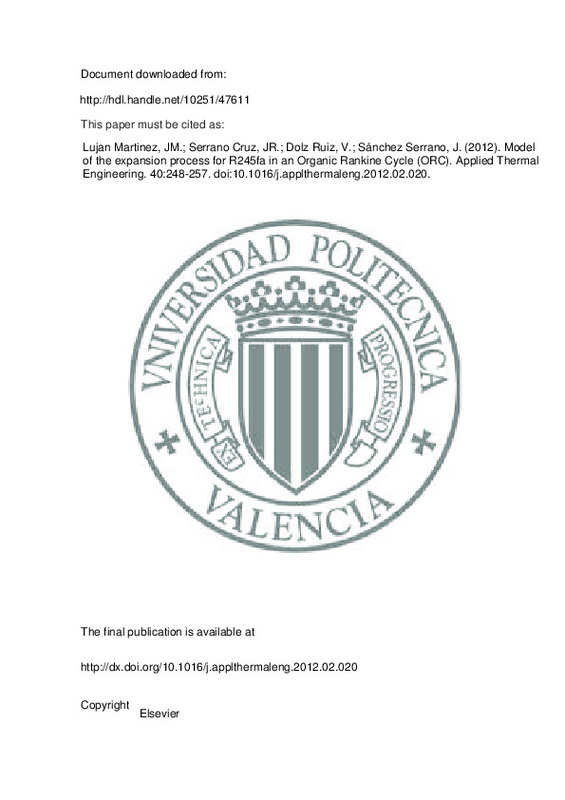JavaScript is disabled for your browser. Some features of this site may not work without it.
Buscar en RiuNet
Listar
Mi cuenta
Estadísticas
Ayuda RiuNet
Admin. UPV
Model of the expansion process for R245fa in an Organic Rankine Cycle (ORC)
Mostrar el registro sencillo del ítem
Ficheros en el ítem
| dc.contributor.author | Lujan Martinez, José Manuel
|
es_ES |
| dc.contributor.author | Serrano Cruz, José Ramón
|
es_ES |
| dc.contributor.author | Dolz Ruiz, Vicente
|
es_ES |
| dc.contributor.author | Sánchez Serrano, Jaime
|
es_ES |
| dc.date.accessioned | 2015-03-02T13:25:09Z | |
| dc.date.available | 2015-03-02T13:25:09Z | |
| dc.date.issued | 2012-07 | |
| dc.identifier.issn | 1359-4311 | |
| dc.identifier.uri | http://hdl.handle.net/10251/47611 | |
| dc.description.abstract | An Organic Rankine Cycle (ORC) is considered as one of the most environmental-friendly ways to convert different kinds of low temperature energies, i.e. solar, geothermal, biomass and thermal energy of exhaust gases into electrical energy. Two important facts about the ORC must be considered: An organic fluid is selected as the working fluid and a high expansion ratio is usually presented in the machinery due to thermodynamic and efficiency factors. In the past, the pre-design of turbomachinery has been based on the usage of ideal fluid laws, but the real gas effects have a significant influence in the ORC working condition, due to its proximity to the saturation vapor line. In this article, the Equations of State (EoS) (Ideal gas, Redlich-Kwong-Soave and Peng-Robinson) have been evaluated in a typical ORC expansion in order to observe the inaccuracies of the ideal gas model with different thermodynamic variables. Finally an isothermal process followed by an isochoric process is proposed to reproduce the thermodynamic process of the organic fluid expansion by means of simpler equations. In the last point of this paper, several examples of this expansion process have been calculated, in order to analyze the proposed methodologies. It has been concluded that in typical expansion process of ORC (2.5 MPa-0.1 MPa and 1.6MPa-0.1MPa), the PR and RKS equations show deviations between 6% and 8% in specific energy. These deviations are very low compared with the ideal gas equation whose deviations are above 100 %. | es_ES |
| dc.description.sponsorship | This work was partially funded by the "Programa de Formacion de Profesorado Universitario (F.P.U)", "Programa de Apoyo a la Investigacion y Desarrollo de la Universidad Politecnica de Valencia 2010", "Proyectos I+D para grupos de investigacion emergentes 2011" and "Programa de apoyo a la investigacion y desarrollo de la U.P.V (PAID-06-09)". The authors thanks to R. Gatzweiler for his help to improve the English grammar. | en_EN |
| dc.language | Inglés | es_ES |
| dc.publisher | Elsevier | es_ES |
| dc.relation.ispartof | Applied Thermal Engineering | es_ES |
| dc.rights | Reserva de todos los derechos | es_ES |
| dc.subject | Organic Rankine Cycle | es_ES |
| dc.subject | Real gas | es_ES |
| dc.subject | R245fa | es_ES |
| dc.subject | Expansion process | es_ES |
| dc.subject | Equation of state | es_ES |
| dc.subject | Binary mixtures | es_ES |
| dc.subject | Equations of state of gases | es_ES |
| dc.subject.classification | INGENIERIA AEROESPACIAL | es_ES |
| dc.subject.classification | MAQUINAS Y MOTORES TERMICOS | es_ES |
| dc.title | Model of the expansion process for R245fa in an Organic Rankine Cycle (ORC) | es_ES |
| dc.type | Artículo | es_ES |
| dc.identifier.doi | 10.1016/j.applthermaleng.2012.02.020 | |
| dc.relation.projectID | info:eu-repo/grantAgreement/UPV//PAID-06-09/ES/PAID-06-09/ / | es_ES |
| dc.rights.accessRights | Abierto | es_ES |
| dc.contributor.affiliation | Universitat Politècnica de València. Departamento de Máquinas y Motores Térmicos - Departament de Màquines i Motors Tèrmics | es_ES |
| dc.contributor.affiliation | Universitat Politècnica de València. Instituto Universitario CMT-Motores Térmicos - Institut Universitari CMT-Motors Tèrmics | es_ES |
| dc.description.bibliographicCitation | Lujan Martinez, JM.; Serrano Cruz, JR.; Dolz Ruiz, V.; Sánchez Serrano, J. (2012). Model of the expansion process for R245fa in an Organic Rankine Cycle (ORC). Applied Thermal Engineering. 40:248-257. https://doi.org/10.1016/j.applthermaleng.2012.02.020 | es_ES |
| dc.description.accrualMethod | S | es_ES |
| dc.relation.publisherversion | http://dx.doi.org/10.1016/j.applthermaleng.2012.02.020 | es_ES |
| dc.description.upvformatpinicio | 248 | es_ES |
| dc.description.upvformatpfin | 257 | es_ES |
| dc.type.version | info:eu-repo/semantics/publishedVersion | es_ES |
| dc.description.volume | 40 | es_ES |
| dc.relation.senia | 212708 | |
| dc.contributor.funder | Universitat Politècnica de València | es_ES |







![[Cerrado]](/themes/UPV/images/candado.png)

